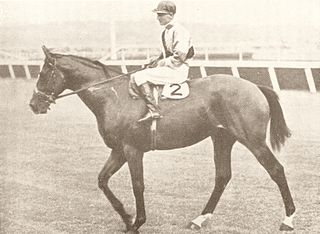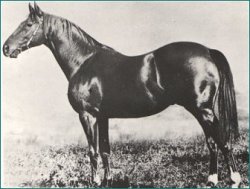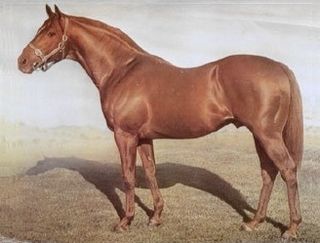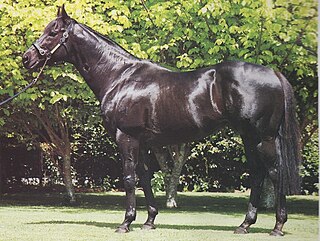Related Research Articles

Thoroughbred horse racing is an important spectator sport in Australia, and gambling on horse races is a very popular pastime with A$14.3 billion wagered in 2009/10 with bookmakers and the Totalisator Agency Board (TAB). The two forms of Thoroughbred horseracing in Australia are flat racing, and races over fences or hurdles in Victoria and South Australia. Thoroughbred racing is the third most attended spectator sport in Australia, behind Australian rules football and rugby league, with almost two million admissions to 360 registered racecourses throughout Australia in 2009/10. Horseracing commenced soon after European settlement, and is now well-appointed with automatic totalizators, starting gates and photo finish cameras on nearly all Australian racecourses.

Vain (1966–1991) was a champion Thoroughbred racehorse that dominated Australian sprint racing in the period 1968–70, when he won 12 of the 14 races he contested and ran second in the other two. He went on to become a leading sire in Australia.

High Caste was a Thoroughbred racehorse and stallion that was bred in New Zealand and was considered the best two-year-old in New Zealand after winning three of his four race starts. He was a good racehorse under handicap and weight for age conditions and combined this with wins in good races from 5 furlongs to 1 3⁄4 miles (2,800 m), carrying up to 10 stone 6 pounds.
Todman was one of the greatest Australian Thoroughbred racehorses and an important sire. He was perhaps best known as the winner of the inaugural STC Golden Slipper in 1957, being the first of Star Kingdom’s five successive winners of the race. He was inducted into the Australian Racing Hall of Fame in 2005.

Ajax was a champion Australian bred Thoroughbred racehorse and sire, who won 18 consecutive races before he was defeated at the odds of 40/1 on, causing a huge racing sensation. He had wins from 5 furlongs (1,000 metres) to 1½ miles (2,400 metres), equalled the Australasian record for a mile (1,600 metres), and created three new race records. At stud in Australia, Ajax proved to be a good sire. He was then sold as a 14-year-old horse and exported to the United States before he was later sold to Bing Crosby and Lin Howard. Ajax was inducted into the Australian Racing Hall of Fame in 2004.

Heroic (1921–1939) was an Australian Thoroughbred racehorse who won 21 races from 5 furlongs to 2 miles (3,200m) and was a leading sire in Australia.

Fastnet Rock is an Australian Thoroughbred racehorse stallion.
Bletchingly (1970–1993) was an Australian Thoroughbred racehorse and stallion. A brilliant sprinter, he was by the successful speed stallion Biscay out of Coogee (GB). Bletchingly was bred by Stanley Wootton on the Baramul Stud in the Widden Valley, and was a three-quarter brother to another high-class sprinter, Beaches. Stanley Wootton had imported Bletchingly's grandsire, Star Kingdom (IRE), from the United Kingdom in the 1950s, and the Irish stallion established Australia's foremost 20th century sireline.

Baguette was an Australian bred Thoroughbred racehorse that was undefeated as a two-year-old and became the first winner of the Two Year Old Triple Crown. His wins included 14 Principal Races and he retired to become a good sire.
Sebring was a top class two-year-old Australian Thoroughbred racehorse, that won five of his six race starts. After winning the AJC Breeders Plate in his spring debut, he had wins in the Golden Slipper and AJC Sires Produce Stakes and second place, defeated by a nose, in the AJC Champagne Stakes.

Noholme (1956–1983) was an Australian Thoroughbred racehorse who was the 1959 Australian Horse of the Year and who took nearly a full second off the race record in winning the prestigious Cox Plate. In 1959 he was Australian Horse of the Year.
Choisir is an Australian-bred dual hemisphere-winning Thoroughbred racehorse. He became the first Australian-trained winner of the Group Two King's Stand Stakes. The same year, Choisir also won the Golden Jubilee Stakes and was second in the July Cup.

Manitoba (1930-1951) was a British bred Thoroughbred racehorse that was a race winner in England before he was exported to Australia where he was a leading sire.

Wilkes was a French Thoroughbred racehorse who became a leading sire in Australia. He had two victories, over 1,500 metres in the Prix Sans Souci at Maisons-Laffitte and the 2,000 metres Prix Edgard de la Charm at Saint-Cloud, for 1,446,200 francs in stakes.

Fisherman was a hardy English-bred Thoroughbred racehorse who won 70 races including the Ascot Gold Cup on two occasions. Exported into Australia he became a leading sire there.

Eurythmic was a versatile Australian-bred Thoroughbred racehorse who had the ability to produce a brilliant finishing run in staying races and he also won important sprint races, too. At four he won 12 of his 13 starts including the Caulfield Cup and Sydney Cup. When Eurythmic finished racing he was the greatest stake-winner in Australia. He was later inducted into the Australian Racing Hall of Fame.

Encosta De Lago was an Australian bred Thoroughbred racehorse that won three group races from eight starts including the Group One (G1), Vic Health Cup against older horses. He was the Leading sire in Australia during 2008 and 2009.

Wenona Girl was a leading Australian Thoroughbred horse racemare that had 27 wins over distances ranging from 4½ furlongs to 1½ miles. She won 22 principal races, 15 of which were later designated group one (G1) races. Wenona Girl’s principal wins included the VRC Sires Produce Stakes, AJC Sires Produce Stakes, George Adams Handicap, One Thousand Guineas, VATC Futurity Stakes, AJC George Main Stakes, AJC All Aged Stakes, AJC Adrian Knox Oaks Stakes, Rawson Stakes and Rosehill Guineas, all of which were later classified as G1 races. At the time of her retirement she was the highest stakes winning mare to have raced in Australia. At stud she was a good broodmare. Wenona Girl was later inducted into Australian Racing Hall of Fame.
Marscay was a champion Australian Thoroughbred sire and racehorse.

Zephyr Bay was an Australian Thoroughbred racehorse and stallion.